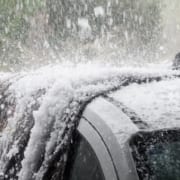How to Fail a Smog Check

In many U.S. states, a regular smog check is a requirement for registering your car. Fail to get the test done or fail the test, and you cannot renew your auto registration. No auto registration, no car insurance. Drive without proof of car insurance and current tags, and you’re looking at hefty fines, maybe even suspension of your license, traffic school and other time- and money-sucking penalties. So, actually you don’t want to fail your smog check, but knowing the many ways that you could fail should help you pass it.
Who Needs a Smog Check?
Every state has its own laws regarding smog check requirements. Often, they’re based on the age of your vehicles. In some cases, it depends on where you reside within the state (usually by county) or your residency status. Seventeen states have no requirement. Some require annual checks, others, every two years. And some states waive the requirement for really old cars. If you aren’t sure, check with your state’s Department of Motor Vehicles to see wether or not you are required to have an emissions test performed.
What Are They Checking?
The standards for acceptable emission levels are set by the states, following common guidelines established by the federal Environmental Protection Agency. There are different standards for light vehicles (what most of us drive) and heavy duty vehicles like commercial trucks.
Smog checks use Acceleration Simulation to monitor the emissions of five gases — hydrocarbons, carbon monoxide, nitrogen oxides, carbon dioxide and oxygen. Excessive levels of any of them can indicate that your vehicle is a pollution creator. CarsDirect.com gives these examples of common causes for high gas levels:
- High hydrocarbon means fuel is going through your engine without being burned. It could be the result of problems with your ignition system, gasket leaks, burned valves or the dreaded (and insanely expensive to replace) catalytic converter failure.
- High nitro oxide is often caused by excessive heat in the combustion chamber, often caused by a faulty Exhaust Gas Recirculation System.
- High carbon monoxide results from incomplete combustion in the engine, which then leads to high oxygen levels.
- High carbon dioxide is often due to a weak ignition, but it can also be caused by too rich a fuel mixture because of a contaminated oxygen sensor or leaky injectors.
If your car is a 1995 or older model, and your state still requires that it be smog checked, the technician will use a Two-Speed Idle to test for emission gases.
Common Causes of Functional Inspection Failure
The second part of your smog test is the functional inspection, a hands-on look-see at your engine ignition timing, check engine light, gas cap and filler neck and exhaust recirculation valve. It will also include a fuel EVAP test. Typically, most of this work is done by analyzing your On-Board Diagnostics (OBD) computer system. Common opportunities to fail include:
- Check Engine Light Tests. If it’s lit or fails to light under specific test conditions, you fail.
- Readiness Flag Tests. 1996 and newer vehicles will fail if readiness flags are not set. Here’s how that works, according to SmogTips.com. “Readiness flags indicate that certain emissions systems which the OBD II computer has been monitoring have passed the internal self-monitoring tests, indicating that those systems are working properly. If the smog machine detects that there are certain readiness flags which have not been set, the data will be relayed to the smog machine and your vehicle will fail the smog test.” A common, but little-known cause of this failure results from a recently disconnected battery. This resets all the readiness flags and you have to put one to three drive cycles on your car to rest the required flags. The Connecticut Emissions Program FAQ page offers these tips for effecting a drive cycle:
- Drive your car at least three separate times that require you to turn it on and off. One should be local in-town driving, another should be on the highway, and the third should be after the car hasn’t been driven for a prolonged period (e.g. overnight)
- The gas tank should be ¼ to ¾ full
- Drive smoothly and avoid rapid acceleration
- Trouble Code Test. This is not applicable to vehicle model years 1995 or older.
Do not count on a friendly, understanding technician cutting you any slack. He’s heard every excuse and he’s not going to risk his lucrative state-issued smog test certification status to do you a solid.
Get It Fixed
If you fail your emissions test, you will be given a report by the inspection tech with details of what you need to repair. Get the work done and take your car back in for a second inspection. If you fail again, you may be able to apply for a smog test waiver, depending on where you live. All this is a big time suck that can best be avoided with regular maintenance.
If you pass, congrats. Now make sure your car insurance is current. You can shop for competitive quotes online and look for cheap car insurance here.


 EINSURANCE
EINSURANCE
 EINSURANCE
EINSURANCE